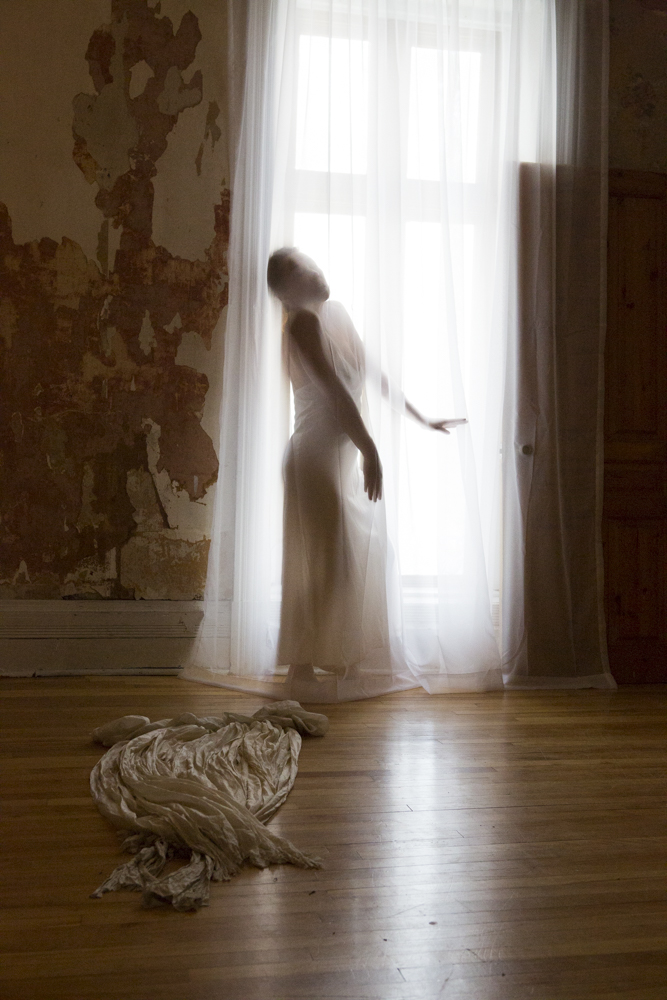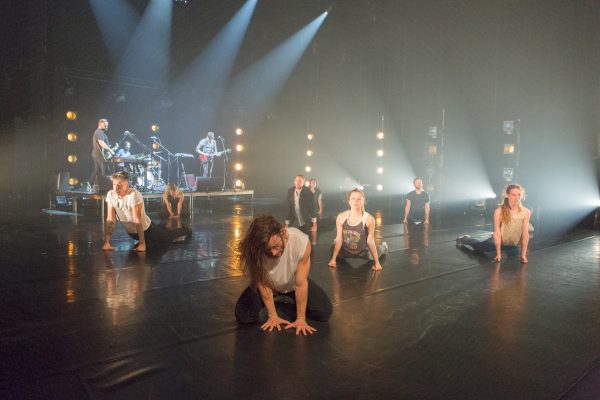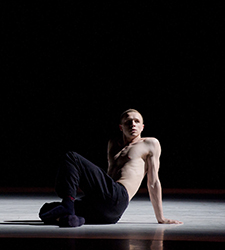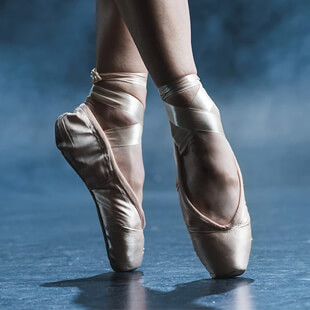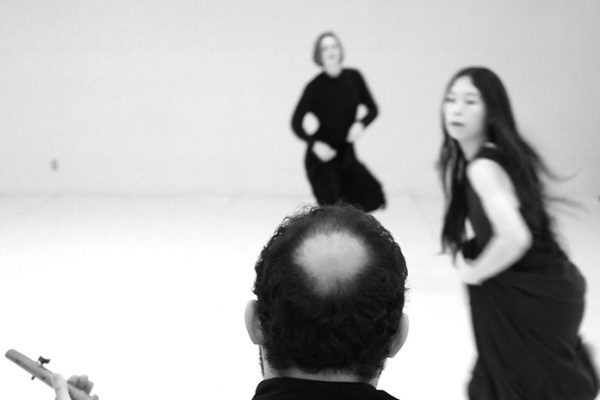The first time we encounter Jocelyne Montpetit in her solo work Runaway Girl she’s huddled in a darkened room, clutching her hair to her face and listening to blues music. Runaway Girl is staged in Montpetit’s childhood home, and we only discover the choreographer-performer after poking our heads around a sliding French door in the front hallway. It takes a few seconds to make out the shape of a human in the gloomy darkness, and then the realization strikes with a small jolt of panic. One by one, we peek in and then pull our heads back, like embarrassed intruders.
Runaway Girl is born out of Montpetit’s painful confrontation with her past. In an interview in the show notes, she explains that when the family house was bequeathed to her after her father’s death, she was “stricken with anxiety, overwhelmed by the distress of returning to [her] place of origin.” Forced to sort through everything and deal with it all, she invites us to the denouement of that difficult process. Each showing permits an audience of only ten or twelve people, and by the time we file in through the front door, all that’s left are a small number of vital items, each too heavy with significance to be jettisoned: a beat-up armoire, a few pairs of battered ballet slippers, a collection of old tools, a Leonard Cohen album — and then Montpetit herself, wearing a tattered white dress and crouched in the darkest corner of the pit of sorrow.
With one out-flung arm, she achingly pulls open the door to let in the light and our prying eyes. So the choreography begins, and what follows is a ceremony for letting go. Her movements carve the contours of the dead and disappeared, like a liturgy of conjuring. Montpetit takes the burdens of the past and causes them to float around her. She caresses these ghosts one by one, even though each gesture confirms that they aren’t really there.
Montpetit’s childhood home contains not just personal memories but also civic memories. In the notes, she describes it as a place where artists, musicians and “counterculture types” were often passing through. Her memories are tinged with a “great solitude” because there were no other children in her milieu. That solitude is the defining feature of the work. Despite her intimate proximity to the audience, Montpetit remains mysteriously far away. Runaway Girl is a portrayal of someone who is lost inside herself, and so even when she passes among her onlookers, the gulf remains.
Montpetit’s choreography draws deeply on her vast experience as a butoh artist, especially in the way she makes her body a lightning rod for pain and expresses raw emotion with her face. It would be correct to describe Runaway Girl as a work of dance-theatre, but thankfully there isn’t any detailed content — no stories told or characters evoked. The absence of referents leaves the work free to make its impact directly.
To see Montpetit in her frayed white dress, captured by the memories of an old home, one thinks of Miss Havisham from Great Expectations. Montpetit’s performance expresses sorrow not only at what is gone but, like in Dickens’ tale, also at what might have been. The knife-edge to Montpetit’s sorrow isn’t just loss but also regret. In Runaway Girl, we experience the merciless truth that the past can never be changed or fixed. But unlike Miss Havisham, Montpetit faces her grief head-on and allows it to wash over her. Her courage pays off — it leads to a radical ending.
~
Mette Ingvartsen’s 7 Pleasures is already underway as we find our seats. A simple driving beat creates a club-like atmosphere in the theatre and lends a buzzy energy to the usual nesting rituals: tucking bags, draping jackets, peeking around. Suddenly, some people stand up from their seats and begin peeling off their clothes. It’s a savvy crowd at Usine C on the second night of Montréal’s Festival TransAmériques, but even for this seasoned audience, the alertness in the room sharpens palpably as dancers strip in their midst. One by one, twelve nude dancers descend to the stage and arrange themselves in a heap.
From the beginning, it’s clear that Ingvartsen’s choreography puts nudity at a closer proximity than even experienced dance audiences are accustomed to. Not only do the naked dancers squeeze past our knees on their way to the aisle but also they touch each other almost constantly throughout the performance. In the second movement, the percussive theme from the opening gives way to a low electronic hum, and the dancers tumble slowly across the floor in a rapturous, roiling mass, like a tangle of copulating snakes. The contact is unrestrained and indiscriminate: genital to shoulder, belly to foot, cheek to thigh. In the process, the various parts of their bodies are stripped of their individual significance. An arm is not an arm and a leg is not a leg; all is flesh.
Nudity in contemporary dance doesn’t necessarily demand much contemplation. For many choreographers, it is simply a technique for arriving more directly at the substance of the work. In 7 Pleasures, however, nudity is everything. It is the question, the lens, the language, the intention and the terrain of the work. Above all, it is the material. Ingvartsen invites us to reconsider the flesh; she wants us to confront its creaturely power and sensual potential, unchained from popular imagery of sex in advertisements and pornography. Through movements that are at once limpid and yet taut, or aggressive and yet joyful, Ingvartsen’s choreography takes a big step past titillation and arrives at sexual incarnation.
True to its title, 7 Pleasures is organized into seven sections. Each movement toggles the frequency back and forth from a high pitch (and at times, total manic chaos) to a low, guttural vibration. But whether they are boiling over and bouncing around or luxuriating in the magma of their fat, muscle, skin and blood, the dancers give the impression of continually experiencing their bodies for the first time. They’re like blind alien babies pulsing into human form, trying out the world in all the ways possible.
One of the things that makes this work so successful is the way the performers extend their raw sensuality in all directions uniformly, not just to each other but to objects as well. We see them share gorgeously debauched moments with a low coffee table, for example, or a potted plant. I was worried that we would arrive at a binary narrative when the clothes start coming back on toward the end, like this was all an opium dream, but Ingvartsen refuses to resolve it so easily; the dancers’ pants and jackets extend the sensuality by adding a power dynamic. Ultimately, the rules of decorum don’t win out when their bodies are covered either. In 7 Pleasures, Ingvartsen shows us an alternate reality, and it’s clear at the close: there’s no need to come back.
~
It wasn’t until the final days of the Festival TransAmériques that audiences had a chance to check out French choreographer Rachid Ouramdane’s Tordre, which was performed on two consecutive nights at the Théâtre Rouge du Conservatoire in Montréal’s Mile End. Tordre presents a “double portrait” of two unique performers: Annie Hanauer, an accomplished American dancer based in the UK and France who happens to wear a prosthetic arm, and Lora Juodkaite, a Lithuanian choreographer with an otherworldly ability to spin.
We meet this intriguing pair in a mock ceremony that’s reminiscent of how athletes present themselves at competitions. (Hanauer performed at the Olympic Games in Beijing and the Paralympic Games in London.) A scrap of fanfare ushers them onstage — the set is white and bare except for two contraptions hanging from the ceiling, each consisting of a horizontal and vertical metal bar — and they parade around in triumphant postures, arms raised and chins high, like gladiators or synchronized swimmers. Then the music cuts off, they exit, and the process is repeated several times with subtle variations.
There’s an irony to this affected introduction, but also a utility. The self-conscious display compels the audience to become aware of itself as a corpus of onlookers with demands and expectations: we’re here to be impressed, and the objects of our admiration (or criticism) are the two individual humans parading themselves around like specimens. By satirizing the theatrical context and poking at the blurriness around dance as both art and sport, Ouramdane cleverly reflects our perceiving gaze as the instrument of judgment. Next, his task is to contort that perception — in French, tordre means “twist” — out of its reductive track.
Ouramdane has chosen dancers who have “sublimated their difference,” he says in an interview included in the handbill. Except for her powerful athletic physique, Juodkaite’s distinctness isn’t immediately apparent, but Hanauer possesses what we might stereotypically call a physical disability; though after watching her dance, no sane person would use the term. She performs the first solo, and it’s quickly obvious that her artificial limb sets no limit on her expressiveness or grace in movement. The choreography plays with gravity, pulling her body in different directions and tracing a line between self-possession and abandon. Artful phrases are overtaken by small storms of movement or mechanical glitches, suggesting that Ouramdane wants us to be aware of the frame we might impose because of her prosthetic arm.
Then it’s Juodkaite’s turn. She comes spinning out from the wing with confident and precise steps. Juodkaite’s performance is a revelation that hits you in waves. At first, she spins a long time, and you admire her fortitude. Then she keeps spinning, longer than seems humanly possible, and admiration gives way to confusion and awe. She just keeps spinning, every turn flawlessly unwavering, and it becomes almost disturbing. She incorporates her arms and head, forming surprising three-dimensional shapes. Watching her move onstage, it’s easy to believe that no one in the history of the species has been able to spin like this. It goes past the point of art, into some rarely explored territory between circus act and spiritual rite.
Ouramdane makes a few attempts to twine together these disparate performances, but Tordre mostly functions like a double helix, with the two dancers looping around each other but rarely connecting. This woven interaction forms a strong cord throughout the work but, unfortunately, Tordre also has some glaring weaknesses. Juodkaite delivers a monologue during a later solo that explains her backstory with spinning, and though the tale is affecting enough, it’s cut with bad poetry: ambiguous feelings vaguely expressed, loose sentences floating in self-romanticizing melancholy.
In another uncomfortable section, Hanauer performs to Nina Simone’s amazing cover of Morris Albert’s 1974 song Feelings. It’s Simone at her wildest pitch of genius, both vulnerable and threatening; listening to her sing this song is like getting kissed and punched at the same time. Ouramdane could have turned off the lights and played the track, and the experience would have been intense enough. Instead, Hanauer delivers a recital-worthy interpretation, illustrating the verses with playful hand gestures, as though anyone wanted to see Simone’s awesome power translated into bouncy charts in the air by a young white woman. Maybe the discrepancy is supposed to twist our perception, but I don’t see who benefits or how.
Tordre has a lot to recommend it, but these missteps suggest an aimlessness that is confirmed by the ending, which is as much of a throwaway as I have ever seen. Although Ouramdane starts down an intriguing path, he ends up wandering. But as he says in the handbill, Tordre isn’t so much a choreography of gestures as “a choreography of presence,” and the individual encounters with Juodkaite and Hanauer are profound on their own, and well worth experiencing.
Tagged: Contemporary, Montréal , QC
